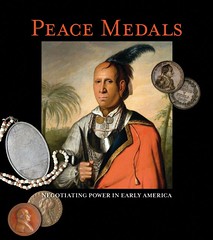
PREV ARTICLE
NEXT ARTICLE
FULL ISSUE
PREV FULL ISSUE
NEW BOOK: PEACE MEDALS: NEGOTIATING POWER IN EARLY AMERICA
The November 28, 2011 issue of Coin World announced a new book on Indian Peace medals. The book is a companion to an upcoming exhibit (December 4, 2011 – April 1, 2012) at the Gilcrease Museum on Tulsa, OK. Here's an excerpt from the Gilcrease web site.
-Editor
The U.S. government negotiated with powerful chiefs to secure their political allegiance against other colonial powers (Great Britain, France and Spain) and to create trading partnerships. "Peace and friendship" was a noble phrase, but one that that rarely described the real interactions between the government and Native tribes. Beautiful examples of the artistry of coins and medals, these peace medals selected from the Gilcrease collection are most notable for their historical significance. They serve as important symbols of the turbulent times that saw the birth of the American nation and its rise to world prominence. Peace medals also represent promises, kept and broken, made by our government to Indian peoples across the continent. To read the complete article, see: Peace Medals: Symbols of Influence and Prestige in North America (www.gilcrease.utulsa.edu/Explore/Exhibits/Future-Exhibits/Peace-Medals)
The book will be available for $19.95 at the University of Oklahoma Press site.
-Editor
Peace Medals
Contributions By: John W. Adams, Bruce W. Arnold, George J. Fuld, Frank H. Goodyear III, Duane H. King, Skyler Liechty, Tony Lopez, F. Kent Reilly III, Barry D. Tayman
Edited By: Robert B. Pickering
The contributors, including numismatic historians, anthropologists, archaeologists, and museum curators, explore how the American government used the medals in negotiations with powerful chiefs to secure trading partnerships and political allegiance against European colonial powers, and also discusses British, French, and Spanish medals as part of European negotiating strategies to create Indian allies on the American continent. The origin of peace medals and their synchrony with tribal traditions demonstrate how these high-status emblems evolved, while an examination of medals in a contemporary context reveals their continuing historical importance. Peace Medals is richly illustrated with paintings and historical photographs that depict rarely seen images of British, French, and Spanish medals in addition to a selection of American medals. Taken together, the articles provide an expansive view of medallic artistry from the eighteenth to the twentieth century and offer new insights into their history. Most of the images are from the extraordinary collections of the Gilcrease Museum.
To read the complete article, see:
Peace Medals: Negotiating Power In Early America
(www.oupress.com/ECommerce/Book/Detail/1651/peace%20medals)
The Numismatic Bibliomania Society is a non-profit organization promoting numismatic literature. See our web site at coinbooks.org. To submit items for publication in The E-Sylum, write to the Editor at this address: whomren@gmail.com To subscribe go to: https://my.binhost.com/lists/listinfo/esylum All Rights Reserved. NBS Home Page Contact the NBS webmaster 
|
